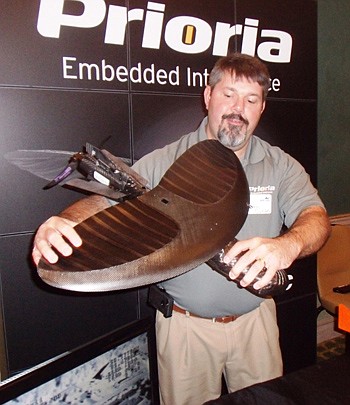
Like children waiting for Santa Claus, developers of unmanned aircraft — the robotics technology popularly known as drones — are chomping at the bits.
So are executives from a variety of industries whose efficiencies and opportunities stand to greatly improve when the U.S. Federal Aviation Administration lifts its ban on commercial drone use, perhaps as early as 2015. Those industries range from agribusiness to weather forecasting to disaster response.
Meanwhile, a new educational sector is emerging. Hundreds of student pilots nationwide are preparing for a job market that doesn’t exist yet, but is expected to proliferate when flying drones in U.S. airspace becomes legal.
“The opportunities for commercialization are wide open,” said U.S. Rep. Ander Crenshaw.
The Jacksonville Republican said FAA regulations are an unjust hindrance to business opportunities created by drone technology.
“We need to get through the regulations that are holding us back,” Crenshaw said.
Drones are aircraft without a flight crew on board. With varying shapes and sizes, and having a range of characteristics and capabilities, the devices are remotely controlled by people or computers.
Crenshaw joined a panel of industry leaders and scholars Tuesday at the JAX Chamber Unmanned Systems Forum at the Hyatt Regency Jacksonville Riverfront.
Although Crenshaw described the FAA as “uncooperative,” panelist Paul McDuffee said the federal agency is meticulously, yet efficiently, reviewing the complex issues associated with opening up national airspace for government and commercial drone use.
The FAA and the rising industry that falls within its regulatory domain have similar goals, the most significant of which is safety, said McDuffee, government relations and strategy president for Insitu Inc., Boeing’s unmanned aircraft subsidiary.
“There is a lot of cooperation within the FAA,” said McDuffee, noting that at Congress’ direction, the FAA is working the Department of Defense, Homeland Security, other agencies and the private sector
The FAA’s technical challenges include resolving how much training to require of ground-based pilots, how to ensure that drones fly safely if pilots lose contact with them and how drones and commercial aircraft should warn each other when they’re in the same area.
“These systems have been wildly successful beyond what we ever imagined. There are plenty of issues, but we have chosen to ignore the problems,” said panelist John Coffey, Unmanned Systems Division vice president of the Huntsville, Ala., engineering firm TriVector Services Inc.
The Association for Unmanned Vehicle Systems International, which organized the JAX Chamber forum and its accompanying exhibition, estimates that unmanned vehicles and associated technologies are an $82 billion-a-year, 100,000-job industry in the making.
“It’s not about the vehicle; it’s about the technology. It’s not about platform; it’s about all the other enabling capabilities. And Florida is in a good position
for this revolution,” said forum moderator Brent Klavon, the AUVSI Florida Peninsula chapter vice president.
Nearly a year behind schedule, the FAA released a five-year roadmap and an unmanned aircraft systems comprehensive plan to allow government and private aircraft in national airspace by September.
The unmanned aircraft industry’s modern-day history dates back to 1994, when a drone was used to assist the commercial fishing industry by remotely leading anglers to tuna.
Today, the unmanned aircraft industry’s potential is so robust that it may have as much impact on aviation as the jet engine and “may be the last great innovation in aviation history,” McDuffee said.
To the entrepreneurs at the forum, McDuffee said, “If you are in the room, you could be part of a special thing.”
The FAA estimates about 7,500 unmanned aircraft weighing 55 pounds or less will be in use within five years of creating a regulatory framework for
drones.
The next step in the regulatory process is for the FAA to designate six experimental locations for researchers to test flying drones in general airspace.
Florida is among 25 states competing for the project.